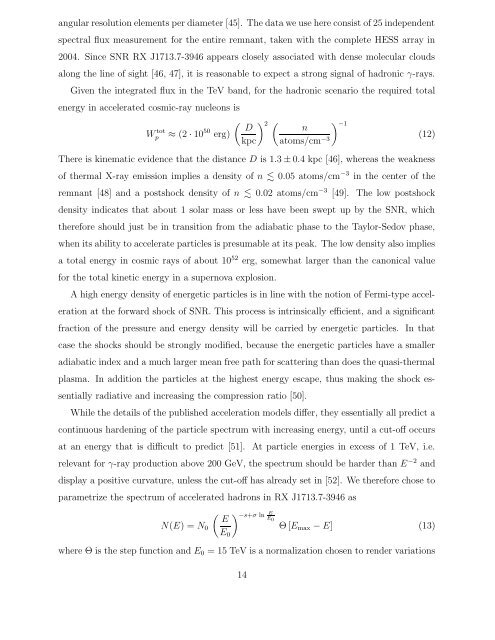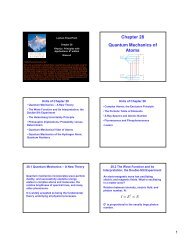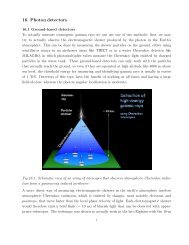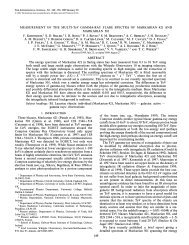Gamma-Rays Produced in Cosmic-Ray Interactions and TeV-band ...
Gamma-Rays Produced in Cosmic-Ray Interactions and TeV-band ...
Gamma-Rays Produced in Cosmic-Ray Interactions and TeV-band ...
You also want an ePaper? Increase the reach of your titles
YUMPU automatically turns print PDFs into web optimized ePapers that Google loves.
angular resolution elements per diameter [45]. The data we use here consist of 25 <strong>in</strong>dependent<br />
spectral flux measurement for the entire remnant, taken with the complete HESS array <strong>in</strong><br />
2004. S<strong>in</strong>ce SNR RX J1713.7-3946 appears closely associated with dense molecular clouds<br />
along the l<strong>in</strong>e of sight [46, 47], it is reasonable to expect a strong signal of hadronic γ-rays.<br />
Given the <strong>in</strong>tegrated flux <strong>in</strong> the <strong>TeV</strong> b<strong>and</strong>, for the hadronic scenario the required total<br />
energy <strong>in</strong> accelerated cosmic-ray nucleons is<br />
W tot<br />
p<br />
≈ (2 · 10 50 erg)<br />
( D<br />
kpc<br />
) 2 (<br />
n<br />
atoms/cm −3 ) −1<br />
(12)<br />
There is k<strong>in</strong>ematic evidence that the distance D is 1.3 ± 0.4 kpc [46], whereas the weakness<br />
of thermal X-ray emission implies a density of n 0.05 atoms/cm −3 <strong>in</strong> the center of the<br />
remnant [48] <strong>and</strong> a postshock density of n 0.02 atoms/cm −3 [49]. The low postshock<br />
density <strong>in</strong>dicates that about 1 solar mass or less have been swept up by the SNR, which<br />
therefore should just be <strong>in</strong> transition from the adiabatic phase to the Taylor-Sedov phase,<br />
when its ability to accelerate particles is presumable at its peak. The low density also implies<br />
a total energy <strong>in</strong> cosmic rays of about 10 52 erg, somewhat larger than the canonical value<br />
for the total k<strong>in</strong>etic energy <strong>in</strong> a supernova explosion.<br />
A high energy density of energetic particles is <strong>in</strong> l<strong>in</strong>e with the notion of Fermi-type acceleration<br />
at the forward shock of SNR. This process is <strong>in</strong>tr<strong>in</strong>sically efficient, <strong>and</strong> a significant<br />
fraction of the pressure <strong>and</strong> energy density will be carried by energetic particles. In that<br />
case the shocks should be strongly modified, because the energetic particles have a smaller<br />
adiabatic <strong>in</strong>dex <strong>and</strong> a much larger mean free path for scatter<strong>in</strong>g than does the quasi-thermal<br />
plasma. In addition the particles at the highest energy escape, thus mak<strong>in</strong>g the shock essentially<br />
radiative <strong>and</strong> <strong>in</strong>creas<strong>in</strong>g the compression ratio [50].<br />
While the details of the published acceleration models differ, they essentially all predict a<br />
cont<strong>in</strong>uous harden<strong>in</strong>g of the particle spectrum with <strong>in</strong>creas<strong>in</strong>g energy, until a cut-off occurs<br />
at an energy that is difficult to predict [51]. At particle energies <strong>in</strong> excess of 1 <strong>TeV</strong>, i.e.<br />
relevant for γ-ray production above 200 GeV, the spectrum should be harder than E −2 <strong>and</strong><br />
display a positive curvature, unless the cut-off has already set <strong>in</strong> [52]. We therefore chose to<br />
parametrize the spectrum of accelerated hadrons <strong>in</strong> RX J1713.7-3946 as<br />
N(E) = N 0<br />
( E<br />
E 0<br />
) −s+σ ln<br />
E<br />
E 0<br />
Θ [Emax − E] (13)<br />
where Θ is the step function <strong>and</strong> E 0 = 15 <strong>TeV</strong> is a normalization chosen to render variations<br />
14







